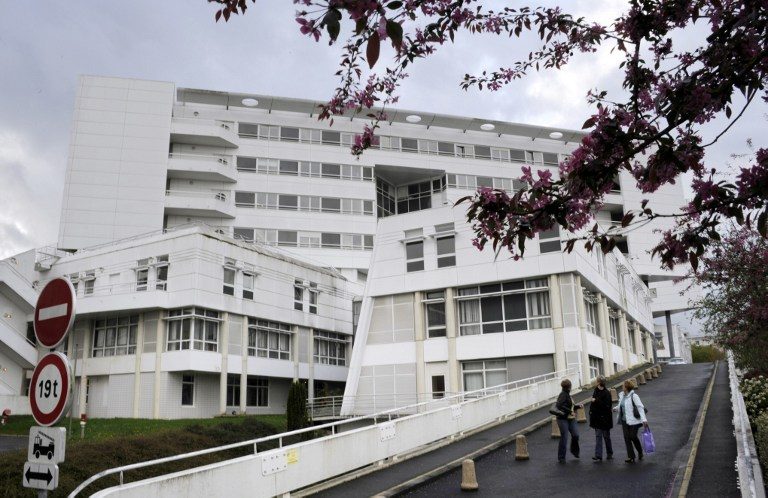SUMMARY
This is AI generated summarization, which may have errors. For context, always refer to the full article.

PARIS, France (UPDATED) – A “serious accident” during a drugs trial in France has left one person brain-dead and five hospitalized, Health Minister Marisol Touraine said Friday, January 15.
She said the six had been taking part in a “trial of an oral medication being developed by a European laboratory” in the northwestern city of Rennes.
According to a source close to the case, the drug was a painkiller containing cannabinoids, an active ingredient found in cannabis plants.
A separate source said the research company Biotrial had been carrying out the drugs trial for Portuguese pharmaceutical company Bial.
“A serious accident took place,” the minister said, adding that the study had been halted and all volunteers taking part recalled. The incident occurred on Thursday.
The study was a Phase I clinical trial, in which healthy volunteers take a prototype medication to “evaluate the safety of its use, tolerance and pharmacological profile of the molecule,” the minister added in a statement.
It was not clear how many people were taking part in the study.
Clinical trials typically have 3 phases to assess a new drug or medical innovation for safety and effectiveness. Human participation in such trials and scrutiny by outside watchdogs are essential for getting market authorization.
Phase I entails a small group of volunteers, and focuses only on safety.
Phase II and Phase III are progressively larger trials, typically involving hundreds or thousands of volunteers, to assess the drug’s effectiveness although safety remains paramount.
Touraine was set to hold a press conference later Friday alongside a manager from the Biotrial company which has its French headquarters in Rennes.
The company conducts its Phase I trials at a 150-bed facility in Rennes and also in Newark, New Jersey, from where it carries out “a large variety of early clinical studies,” according to its website.
Biotrial says it is able to fast-track early patient studies by “combining the favourable regulatory environment in Western Europe with fast and efficient patient recruitment in Eastern Europe.”
The Paris prosecutor’s office said an investigation had been opened.
Touraine said she was determined to “shed light on” what happened. She has also called for an inspection of the research site.
Every year thousands of volunteers, often students looking to make extra money, take part in such clinical trials, which are seen as safe.
Mishaps are relatively rare, but in 2006, 6 men were hospitalized in London after taking part in a clinical trial into a drug developed to fight autoimmune disease and leukemia.
In gene therapy, setbacks have included the death of an 18-year-old US volunteer, Jesse Gelsinger, in 1999, and the development of cancer among 2 French children treated for “bubble baby” syndrome, a chronic lack of immune defenses.
Drug approval: How does it work?
While the process of vetting experimental drugs is designed, with safety in mind, to be cautiously meticulous, things still go wrong.
This is how drug trials work:
After preliminary tests on animals and human cells in petri dishes, a laboratory must obtain permission from health authorities for clinical trials on humans to assess a drug’s safety and effectiveness.
This testing usually consists of 3 phases:
1. Phase I is generally carried out with a sample of fewer than 100 healthy volunteers to assess drug tolerance and check for side-effects. The French trial was in this phase.
Normally, Phase I involves young adults who have passed a medical examination to declare them in tip-top shape.
2. After safety has been established, Phase II evaluates the effectiveness of the drug and the optimal dosage, usually on a sample of several hundred people.
3. Phase III compares the treatment to a dummy drug (placebo) or a medicine already in use – usually testing it on several thousand people. The aim is to confirm the drug’s effectiveness.
Some trials take place in hospitals, others at licensed private institutions.
4. After clinical trials, which can last between five and 10 years, the laboratory applies to a medicines watchdog to bring the drug to market.
In Europe, this is the European Medicines Agency (EMA), and in the United States it is the Food and Drug Administration (FDA).
For approval, a new treatment must demonstrate a benefit/risk ratio that is equivalent to, or better than, any existing drug.
According to the French National Agency for Medicines and Health Products Safety (ANSM), it can take 10 to 15 years from when a drug is first tested in a laboratory to it reaching the market.
Once it becomes commercially available, any new drug remains under surveillance and ongoing assessment of any side effects.
If there are any health risks, it can be taken off the shelves at any time. – Rappler.com
Add a comment
How does this make you feel?
There are no comments yet. Add your comment to start the conversation.